Published on 2025-06-26T05:29:50Z
What is Bot Filtering? Examples in Analytics
Bot Filtering is a process in web analytics for detecting and excluding automated traffic generated by bots, spiders, and crawlers. Without bot filtering, metrics like pageviews, sessions, and conversions can be inflated by non-human visits, leading to misleading insights. By applying filters at the analytics or server level, you ensure your data reflects genuine user behavior. Modern analytics solutions—such as Google Analytics 4 (GA4) and PlainSignal—offer built-in and customizable bot filtering options. They use methods like user-agent matching, IP exclusion, JavaScript challenges, and behavioral pattern analysis to segregate bots from real users. Effective bot filtering not only maintains data integrity but also enhances decision-making, resource allocation, and marketing ROI.
Bot filtering
Filtering out automated bot traffic in analytics to maintain accurate, human-only data and metrics.
Why Bot Filtering Matters
Automated traffic can seriously distort web analytics, leading to wrong conclusions and wasted resources. Bot filtering preserves the integrity of your data and ensures that reported metrics truly reflect human interactions.
-
Protect data integrity
Bots can generate fake pageviews, sessions, and events, leading to inflated traffic numbers and misleading trends.
-
Accurate conversion metrics
Filtering out bots ensures conversion rates reflect real user behavior, guiding better marketing and product decisions.
-
Improve resource allocation
Clean data helps prioritize budget and development efforts based on genuine user engagement rather than automated noise.
Common Bot Filtering Techniques
Analytics platforms and security tools employ multiple methods to identify and exclude bot traffic. Each method has strengths and trade-offs in accuracy, maintenance, and privacy.
-
User-agent & ip filtering
Block known bot user agents and IP ranges via server rules or analytics settings.
-
User-agent filtering
Identify and exclude traffic based on updated lists of bot and spider user-agent strings.
-
Ip address blocking
Exclude requests from known data centers, hosting providers, or suspicious IP ranges.
-
-
Behavioral analysis
Detect bots by analyzing patterns like rapid page loads, zero interaction time, or impossible navigation paths.
-
Javascript challenges & honeypots
Use script execution and hidden elements to distinguish real browsers from simple crawlers.
-
Javascript execution
Require clients to run JS code, filtering out bots that do not execute scripts.
-
Honeypot fields
Embed hidden form fields or links; bots filling or following them reveal non-human activity.
-
-
Rate limiting & captcha
Throttle excessive requests or prompt challenges to confirm human interaction.
Bot Filtering in PlainSignal
PlainSignal is a privacy-first, cookie-free analytics tool that automatically filters known bots and spiders out of the box, delivering clean metrics without configuration overhead.
-
Out-of-the-box bot exclusion
PlainSignal leverages updated bot lists and behavior analysis to silently remove non-human traffic.
-
Cookie-free tracking
Maintains user privacy by avoiding cookies while still distinguishing bots from real users.
-
Implementation snippet
Embed the following snippet in your HTML to start tracking with PlainSignal’s built-in bot filtering:
-
Example snippet
<link rel="preconnect" href="//eu.plainsignal.com/" crossorigin /><script defer data-do="yourwebsitedomain.com" data-id="0GQV1xmtzQQ" data-api="//eu.plainsignal.com" src="//cdn.plainsignal.com/plainsignal-min.js"></script>
-
Bot Filtering in Google Analytics 4
GA4 provides both automated exclusions of known bots and customizable filters for internal or suspicious traffic, all managed through the Admin interface.
-
Built-in known bot & spider filtering
Enable the toggle in GA4 Admin > Data Settings to exclude traffic from the IAB’s list of known bots and spiders.
-
Configuring internal traffic filters
Define and exclude traffic from your own organization or staging environments based on IP or device parameters.
-
Internal traffic definition
Set rules under Admin > Data Streams > More Tagging Settings > Define Internal Traffic.
-
Data filter application
Apply an Exclude filter to drop internal traffic before it appears in reports.
-
-
Custom event & parameter filtering
Create event or user-property filters to drop or flag suspicious traffic patterns beyond known bots.
-
Event filter rules
Use matching conditions on event names and parameters to exclude unwanted hits.
-
-
Example GA4 setup
Integrate GA4 with basic tracking code; bot filtering settings are applied administratively rather than via code:
-
Example tracking code
<script async src="https://www.googletagmanager.com/gtag/js?id=G-XXXXXXXXXX"></script> <script> window.dataLayer = window.dataLayer || []; function gtag(){dataLayer.push(arguments);} gtag('js', new Date()); gtag('config', 'G-XXXXXXXXXX'); </script>
-
